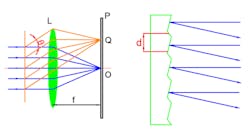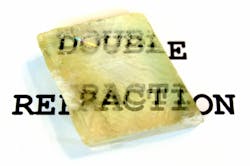Learning Optics with Austin: Lesson 13 – Diffraction Grating and Wave Plates
With the knowledge of interference and polarization, it is time to talk about the practical applications of both! Diffraction gratings are used to change the path of light and there are two types: transmission grating and reflection grating. A transmission grating utilizes diffraction to break light apart into different colors. A reflection grating has a jagged edge that utilizes reflection in changing the path of light. While the methods differ, both types of gratings are used in spectrometers measuring light waves.
Birefringence is a phenomenon where a material distorts light in a way that a single line appears to become two lines when viewed through the material. Calcite exhibits this phenomenon by splitting the light that passes through into ordinary light and extraordinary light. Wave plates are used to reverse this distortion so that a single line continues to appear as a single line.
Birefringence
Wave plates come in three types: quarter-wave plate, half-wave plate, and full-wave plate. Quarter-wave plates make circular polarized light into linear polarized light. Half-wave plates change the direction of linear polarized light. Full-wave plates usually have no effect on the polarization of light unless the wavelength of both the light and wave plate are different, in which case, linear polarized light becomes elliptical polarized light.
Quarter-Wave Plate


